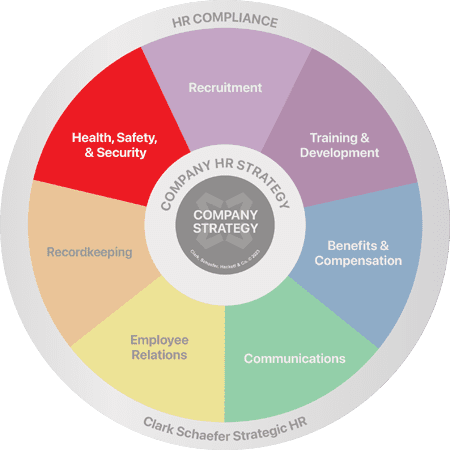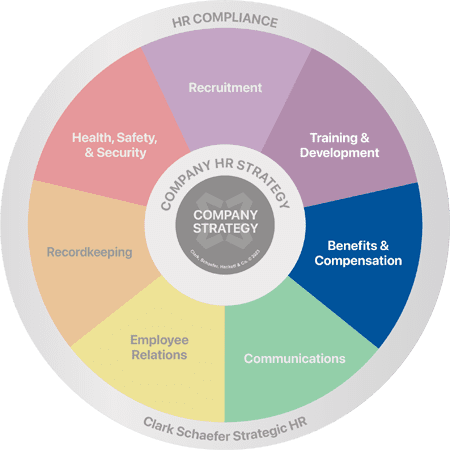Do I Need a Heat Safety Plan? How Do I Build One?
Last Updated on July 12, 2023 / Health, Safety & Security

HR Question:
As an employer, I understand it’s my responsibility to take precautions when employees work outside in the heat. Additionally, I learned that OSHA is now conducting Heat Safety Inspections. Do I need a heat safety plan? If so, how do I build one?
HR Answer:
As summer heats up and the temperatures rise above 80°F, so too will heat-related illnesses. Employers should be aware that OSHA places a duty on employers to protect employees from occupational heat-related illnesses both indoors and outdoors. SHRM reports that employers should prepare for an increase in heat-related workplace inspections by OSHA especially as the heat index rises!
Despite being commonly underreported, the Bureau of Labor Statistics found that since 2011 there have been 436 work-related deaths caused by environmental heat exposure. The death of postal worker Peggy Frank from heat stroke in her mail truck led to legislation that require all postal vehicles to be modified to include air conditioning within three years. In 2021, OSHA announced an enforcement initiative on heat-related hazards, developing a National Emphasis Program on heat inspections, and launching a rulemaking process to develop a workplace heat standard.
Starting a Heat Safety Plan
A job safety analysis will provide a better understanding of the heat risks that your employees experience. Positions commonly at risk for heat-related occupational illness are workers in agriculture, construction, landscaping, and mail and package delivery. Indoor environments such as manufacturing plants and distribution centers can create high-heat environments, which through ambient heat and protective clothing can be just as dangerous as the outdoors. When building your heat safety plan, be particularly mindful of the dangers involved with physically demanding positions and positions requiring bulky equipment or gear in high heat.
Monitor The Heat
When the heat index reaches 80°F or higher, serious occupational heat-related illnesses and injuries increase. This is especially true when employees are not yet acclimatized to the heat, performing strenuous work in direct sunlight, or in radiant heat without frequent access to cool water and shade. Monitor ambient temperatures and prepare for high heat events to ensure adequate measures are taken to protect employee health. Businesses with high-heat environments should establish a heat alert program so adjustments can be made to the physical demands of employees working in high heat. Businesses may consider scheduling hot jobs for cooler parts of the day or planning scheduled maintenance or repair work for cooler seasons.
Evaluate Your Tools
Once there is a thorough understanding of the organization’s heat safety risks, evaluate environmental controls such as air conditioning, fans, heat shields, ventilation, or other ways of reducing radiant heat sources. Investments made in improving employee working conditions will improve productivity and provide a boost to morale. Employers can continue to reduce the risk of occupational heat illnesses by providing frequent breaks, and shaded cooling stations with ample cool water that is easily accessible to workers. Establishing a regular schedule of rest and hydration breaks will promote a culture of well-being where employee health and safety are the top priority.
Pay close attention to new hires in high-heat environments as they have not had an opportunity to acclimate to the environment. Provide even more frequent breaks to new employees and ease them into the physical demands. Providing body cooling and protective clothing such as cooling vests can help reduce the impact of the heat on the employee’s health.
Train Your Managers / Supervisors and Employees
Train employees and managers on heat safety to ensure that everyone knows the signs and symptoms of heat stress and is trained on heat-related illness first aid. OSHA fined a Florida-based employer heavily for exposing workers to hazards related to high ambient heat without adequately training someone to perform first aid and ensure they were available to render assistance in heat-related emergencies. Training is key to ensuring employees are educated on heat-related hazards to manage their exposure, take breaks, stay hydrated, and monitor signs of heat stress. Managers need to be trained on heat-related hazards, safety protocols to reduce heat-related illnesses, and how to obtain first aid for any employee suffering from heat-related illness.
Employers can consult the Criteria for a Recommended Standard: Occupational Exposure to Heat and Hot Environments for more recommendations on how to build a heat safety program and keep employees safe from heat-related illnesses.
Special thanks to Colleen Mahoney, PHR, for contributing to this edition of our HR Question of the Week!
Have you had a safety audit recently? Do you know which OSHA forms you are required to complete? A safe environment plays a key role in keeping a company Healthy, Safe, and Secure. Strategic HR has the expertise you need to ensure your policies and practices are keeping your workers, and customers, safe. Visit our Health, Safety, and Security page to learn more about how we can assist you.






